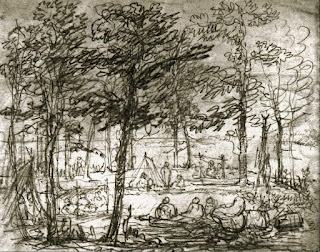Potawatomi Trail of Death - Diary of Jesse C. Douglas, Enrolling Agent under General Tipton, 17 Sept., 1838 6 mi., Sandusky’s Point, Illinois. Remained in camp due to illness. The sick left behind yesterday caught up, had new baby. 3 children and 2 adults died. A child was born. Dr. Jerolaman assisted by Dr. James Buell of Williamsport. Letter excerpt from Father Petit: “I found the camp, under a burning noonday sun, surrounded by soldiers – a scene of desolation with sick and dying people. Nearly all the children, weakened by the heat, had fallen into a state of complete languor and depression. Watercolor "Pottawatamie Equestrians" by George Winter Potawatomi Trail of Death - Diary of Jesse C. Douglas, Enrolling Agent under General Tipton, 16 Sept. 1838 “Travelled 15 mi., crossed state line at noon, camped at Danville, IL. Left 7 persons in camp, one is a woman about to give birth. Whole country afflicted with sickness. Father Petit baptized dying babies.” Paint...
















